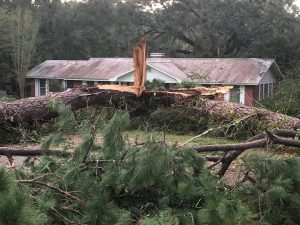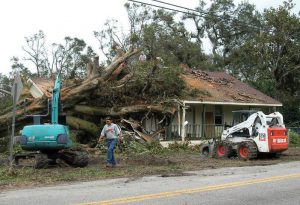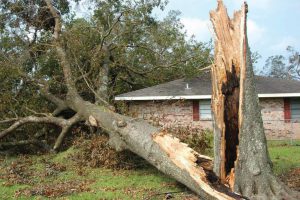Trees have a pretty bad reputation in north Florida these days. They’re on our homes, cars, streets, power lines, and all over the yard causing a lot of grief. While my heart goes out to all of those dealing with trees in places they shouldn’t be, now’s a good time to remember all the reasons we should want trees around. It’s also a good time to review how to minimize tree impacts from future storms.
Benefits of Trees
Beyond being a huge source of oxygen, necessary for many organisms to live, trees provide other benefits such as well. According to a recent analysis of Tallahassee’s urban trees, approximately three million pounds of pollutants, such as carbon monoxide, nitrogen dioxide, ozone, sulfur dioxide, and particulate matter, are reportedly removed each year. The same report calculated that half a billion gallons of precipitation was intercepted by these trees rather than becoming stormwater runoff, reducing impacts of erosion and non-point source pollution. These trees also saved citizens an estimated one million dollars. Total annual benefits to the citizens was over $15 million per year! Researchers have found that trees increase residential or commercial property values an average of 7%!
Ways to Minimize Tree Failure
Select Replacement Trees Wisely
While very few trees could make it through sustained winds of 155 mph, replanting trees sooner will help communities see the benefits mentioned above and help them return to their former beauty. Even the most wind-resistant trees are likely to fail in a storm like Hurricane Michael. UF/IFAS researchers have studied wind-thrown trees following hurricanes and have found these trees to be some of the most wind-resistant – hollies (Ilex spp.), southern magnolia (Magnolia grandiflora), live oak (Quercus virginiana), cypress (Taxodium spp.), cabbage palm (Sabal palmetto), and, interestingly, sparkleberry (Vaccinium arboreum).
The least wind-resistant trees include pecan (Carya illinoiensis), tulip poplar (Liriodendron tulipifera), laurelcherry (Prunus caroliniana), laurel oak (Quercus laurifolia), water oak (Quercus nigra), southern red oak (Quercus falcata), red cedar (Juniperus virginiana), pines (Pinus spp.), and Chinese elm (Ulmus parvifolia).
When replanting, consider planting at least three trees in a group rather than an individual tree, as researchers found that trees in groups fared better.
Tree Care
With existing trees and newly planted trees, taking good care of the tree can help it withstand high winds. In addition to proper pruning techniques and providing adequate root zone space, paying close attention to minimize soil compaction and root zone disturbances will help create a stronger root system. Older trees should be regularly monitored for potential signs of decay.
UF/IFAS has many great resources related to tree health and recovery after hurricanes. A search for Urban Forest Hurricane Recovery Program at our EDIS website (https://edis.ifas.ufl.edu) has several publications to help decide how to move forward and create a healthy urban forest. Let’s not allow our frustration with the tree on the roof to prevent us from recognizing that trees are good.
- Tiny Invaders - February 15, 2024
- Bird Feeder Surprises - January 11, 2024
- Storm Cleanup an Opportunity for Practicing Florida Friendly Landscaping Principles - September 7, 2023



